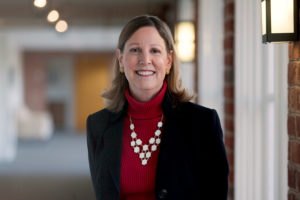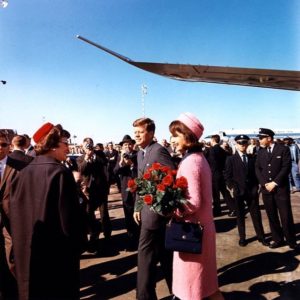Tales from the Crypt: Searching for Answers in the New JFK Assassination Files
Written by Barbara A. Perry, White Burkett Miller Center Professor of Ethics and Institutions and Presidential Studies Director at UVA’s Miller Center. Follow her on Twitter @BarbaraPerryUVA
As I moved through the grocery check-out line this past weekend, my eye fixed on a tabloid headline, “JFK Assassin Worked for the CIA!” Lee Harvey Oswald was a trained operative for the spy agency, according to the National Enquirer. The newly released JFK assassination documents indicate just the opposite, namely, that Oswald did not work for the CIA, based on the agency’s investigation in the aftermath of November 22, 1963. Yet conspiracy theorists, including the tabloid press, turn that conclusion on its head and argue that the CIA engaged in a cover-up of its complicity with Oswald. At least such arguments accept the fact that he perpetrated the act.
When people ask me if the newest records of the Kennedy assassination contain any “smoking guns,” I reply not so far. But wait! We already have three literal smoking guns in the most dastardly crimes perpetrated in America history: the rifle that Lee Harvey Oswald used to ambush President Kennedy from a Dallas sniper’s nest, the pistol that the Marxist malcontent murdered a police officer with as he fled the assassination scene, and the handgun that shady nightclub owner Jack Ruby wielded to kill Oswald on national television two days after the president’s death. And therein lies the eternal mystery. Oswald never confessed, even when told he was dying, and, in fact, infamously said he was a “patsy,” as the Dallas police irresponsibly paraded him before the media. Under questioning, including a polygraph exam that he requested, Ruby claimed that he shot Oswald to spare Mrs. Kennedy the ordeal of a trial. But Ruby was deemed a “depressive psychotic” whose veracity could not be determined under lie detection protocols. How appropriate that two deranged Dallas denizens spawned a half-century of equally crazy theories of the 35th president’s assassination.
As I continue to plow through some 2,800 documents that the government released on October 26, focusing on those that were produced immediately after the tragic event, when the trail was hottest, several observations come to mind:
- Someone with as checkered a past as Oswald, including Soviet and Cuban ties at the height of the Cold War, would inevitably lead the FBI and CIA on wild goose chases across the globe. The files show the FBI tracing Oswald to Mexico City, where he contacted the Russian and Cuban embassies, and intercepting his call with a KGB agent. Unfortunately, the American security establishment lost track of the peripatetic Oswald, who had tried to assassinate right-wing General Edwin Walker in April 1963, and didn’t trace him to his last job at the Texas School Book Depository, on the president’s November 22, 1963, parade route.
- Add ne’er-do-well Ruby to the mix, and the just released FBI memos are a maze of dead-end interviews, especially about the Chicago underworld, with which he had ties.
- Complicating that picture is the fact that the documents put in stark relief the US government’s Mafia links in its dubious efforts to assassinate Castro (a plot known as “Operation Mongoose”). There is even mention of a Ruby sighting in Cuba.
- The 1960s were a decade of political murders, those that we know came to fruition against JFK, Martin Luther King Jr., and Robert Kennedy, and references to other assassinations from FBI informants. One document indicates that a woman told the FBI that Chief Justice Earl Warren would be assassinated at JFK’s funeral, but the FBI concluded that she was simply distraught over the president’s death. The files also contain a list of more than 400 potential presidential assassinations, including Puerto Rican nationals, who, indeed, had tried unsuccessfully to murder President Harry Truman in 1950. Then there is documentation of drunken blowhards boasting that Kennedy would be killed several weeks before he was. The reporter to the FBI of this story had been so drunk himself, however, that he could provide no details of the New Orleans bar where this incident occurred. Not exactly convincing proof of a conspiracy.
- Nevertheless, there is plenty of grist for the conspiracy mills on hand in the current tranche of materials. FBI Director J. Edgar Hoover, himself a colorful and controversial actor in American history, figures prominently. His now much-cited memo from November 24, 1963, covers the Oswald murder and notes that the FBI had cautioned the Dallas police to protect the accused assassin from such mayhem—to no avail. Hoover’s comment that “something” should be “issued so we can convince the public that Oswald is the real assassin” is typical of the kinds of information contained in these files. The statement can be read to indicate that Hoover believed Oswald was the one and only killer or that the devious FBI director was trying to cover up a conspiracy. It would have serious international repercussions, Hoover wrote in the memo, if word spread about a possible connection between the US’s Cold War enemies and Oswald. Conversely, the Soviets, according to a 1965 Hoover memo, thought Kennedy’s Vice President Lyndon Johnson was behind the assassination.
- American Marxists immediately questioned Oswald’s culpability, demanding in an Illinois Communist Party screed, dated December 2, 1963, “What is the truth?”
- One of the most intriguing tales from the JFK files is that a Cambridge, England, journalist reportedly received an anonymous phone call just minutes before the assassination, telling him to call the American embassy in London about a “big story.”
- And let’s not forget the prurient interests served by this latest document dump. They have focused on Robert Kennedy’s alleged involvement with Marilyn Monroe and Martin Luther King’s reported peccadillos. These are hardly new stories. It seems unfair to have a 1964 memo to RFK highlighted when all it did was alert the attorney general to an unsubstantiated book linking him to the Hollywood siren, who had committed suicide in 1962. Although his brother’s relationship with her is undisputed, and who can forget her sultry rendition of “Happy Birthday” to the president a few months before her death, Bobby’s role in the sordid affair is far from clear, even 55 years later. FBI wiretaps on Dr. King, approved by Attorney General Kennedy, attempted to link King’s aides to the Communist Party, a common tactic against leftists during the Cold War. The tapes also revealed that the civil rights leader was unfaithful to his wife, common knowledge in 1960s Washington, as Jacqueline Kennedy observed in her 1964 oral history with Arthur Schlesinger Jr.
Do these new documents take us beyond previous conclusions on the JFK assassination? All four of the US government investigations into the Kennedy murder, starting with the flawed but still valid Warren Commission report, determined that Oswald was the sole killer, with the exception of the House Assassinations Committee in 1978. Although it ruled out conspiracies by the USSR, Cuba, organized crime, FBI, CIA, and Secret Service, the committee determined that a fourth non-Oswald-fired shot could be detected on recordings. Yet more sophisticated acoustical tests have discredited that finding.
Still, 61 percent of Americans continue to believe that a conspiracy snuffed out John Kennedy’s life. That is down from a high of 81 percent, recorded by polls in 1976 (when the only video record of the murder, the Zapruder film, was released in full) and in 2001. Polls also indicate that more Americans are interested in the Kennedy assassination than the historic controversies over Nixon’s Watergate scandal or Clinton’s impeachment. Why? The horrific assault on American freedom perpetrated in Dallas’s Dealey Plaza on November 22, 1963, is seared forever in the nation’s (indeed the world’s) consciousness. JFK, his beautiful wife, and beguiling children are frozen in time that fateful day. Jacqueline Kennedy’s creation of the Camelot mythology around her husband’s presidency ensured its lasting golden hue. Those who canonized President Kennedy cannot accept his martyrdom at the hands of such an inconsequential misfit. Others who felt less positively inclined toward JFK nonetheless simply didn’t accept official explanations of his death. The assassination precipitated a decline in American faith and confidence in the federal government from a high of 75 percent in the early 1960s to a low of 25 percent after the ongoing violence of the 1960s, the Vietnam debacle, and Watergate.
Tellingly, the only segment of the American population who believes the government’s lone gunman theory of the JFK murder is college-educated whites, the same group who rejected Donald Trump’s paranoid, conspiratorial political style that carried him all the way to the White House.
It was Trump’s conspiracy-obsessed sidekick Roger Stone who persuaded him to allow the most recent release of JFK files to move ahead, per a 1992 congressional act, though some documents remain sealed until April, we are told. These might include CIA and FBI files on Oswald, military intelligence, and Secret Service materials. Yet Jon Tunheim, now a federal judge and formerly chair of the Assassination Records Review Board, believes that documents from those agencies may have been destroyed and will never be recovered.
Thus, the Kennedy assassination will remain for many observers of history “a riddle, wrapped in a mystery, inside an enigma,” which, ironically, was a description Winston Churchill applied to Russia in 1939.
- Having a Drink With Your Donkey: The Absurd in Antiquity
- What Happens to UVA’s Recycling? A Behind the Scenes Look at Recycling, Composting, and Reuse on Grounds
- Finding Your Center: Using Values Clarification to Navigate Stress
- UVA Club of Atlanta: Virtual Pilates Class
- UVA Club of Fairfield/Westchester: Cavs Care - Food Pantry Donation Drive
- UVA Club of the Palm Beaches: Hoo-liday Cruise


